-
solutinos
-
Hire
Frontend Developer
Backend Developer
-
NodeJS Developer
-
Java Developer
-
Django Developer
-
Spring Boot Developer
-
Python Developer
-
Golang Developer
-
Ruby on Rails Developer
-
Laravel Developer
-
.NET Developer
Technology
-
Flutter Developer
-
React Native Developer
-
Xamarin Developer
-
Kotlin Developer
-
Cross-Platform Developer
-
Swift Developer
-
MongoDB Developer
-
C Developer
-
Smart Contract Developers
Cloud
-
-
Services
Mobile Development
Web Development
- Work
-
Multi Services App
-
Food Delivery App
-
Grocery Delivery App
-
Taxi Cab Booking App
-
Multi Services App
-
OTT Platform APP
-
Social Media APP
-
Freelance Service App
-
Car Rental App
-
Medicine Delivery App
-
Liquor Delivery App
-
Sports Betting App
-
Online Coupon App
-
eLearning App
-
Logistics & Transportation App
-
Courier Delivery App
-
On-Demand Real Estate App
-
E-Wallet APP
-
Online Dating App
-
Handyman Services App
-
-
Process
-
Company
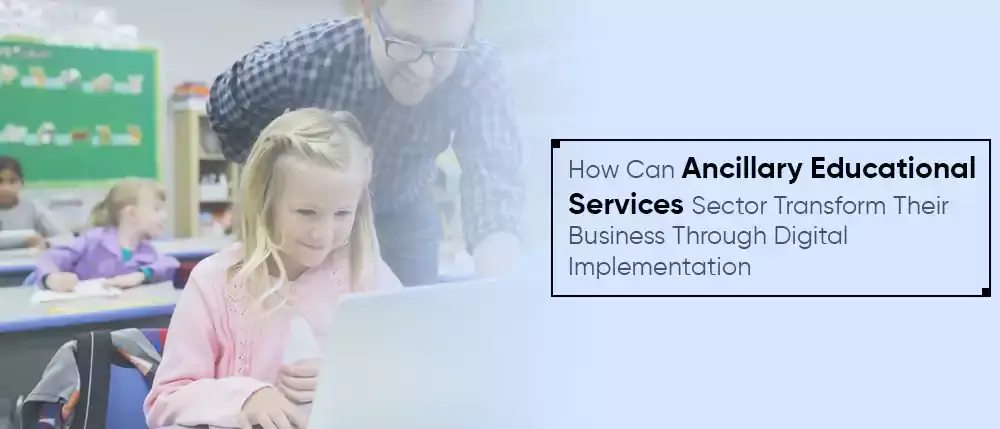
The education sector is an ecosystem of multiple fragments working together. The seamless functioning of the industry would be disrupted – and be evident too – even if one of the fragments failed to do its job or struggle to do what it continues to do.
In our Digital Transformations in the Education Sector Guide series, we have been seeing multiple segments in the ecosystems such as primary education sources, language schools, supplemental education and more and discussing their challenges and solutions.
To ensure these aspects function fine, there is a need for another sector to function perpetually and we call this the ancillary educational services. For the uninitiated, this by itself is a bubble containing multiple sub-sectors and fragments. To help you get a quick idea, here is what the ancillary educational services sector is made up of:
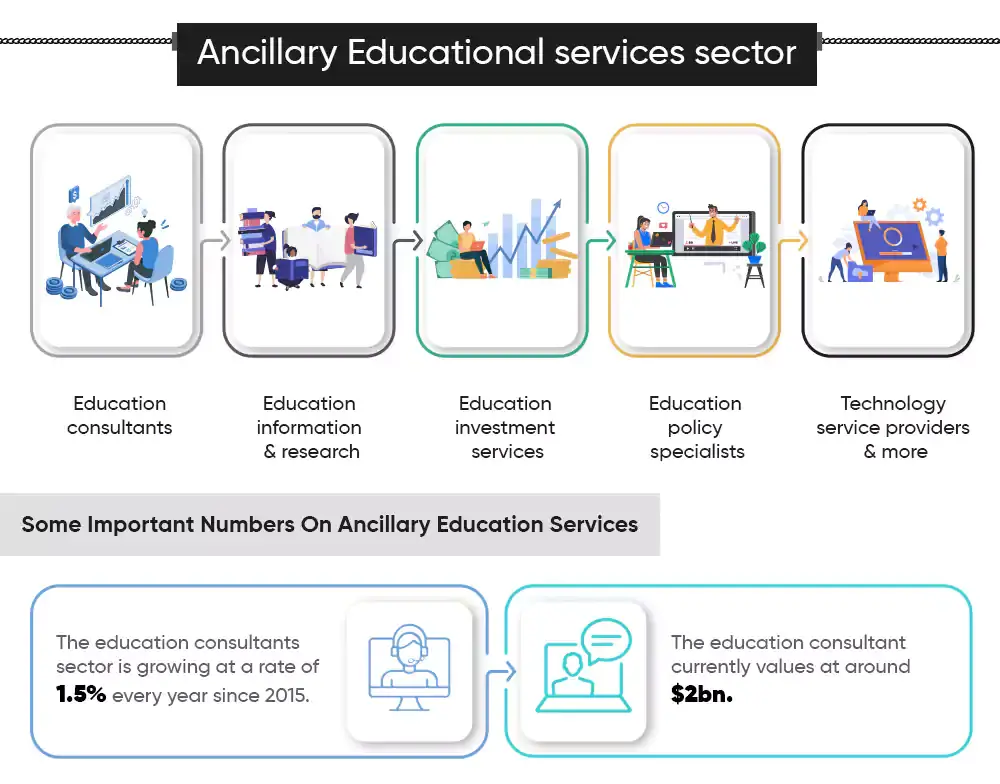
- Education consultants
- Education information and research
- Education investment services
- Education policy specialists
- Technology service providers and more
If you notice, they all shape and influence the holistic functionality of the education sector. And to be honest, there are tons of loopholes and concerns prevailing in this sector that is mainly due to the lack of tech innovation in it. However, that's exactly what we are about to shed light on in this particular post.
So, let's get started with the challenges and solutions involved in the ancillary educational services sector. But before that, do check out our previous posts on the other education sectors in case you missed out on some crucial pointers. There are tons of takeaways that could be resourceful to you.
Some Important Numbers On Ancillary Education Services
- The education consultants sector is growing at a rate of 1.5% every year since 2015.
- The education consultant currently values at around $2bn.
Analysing The Challenges Involved In The Ancillary Education Services
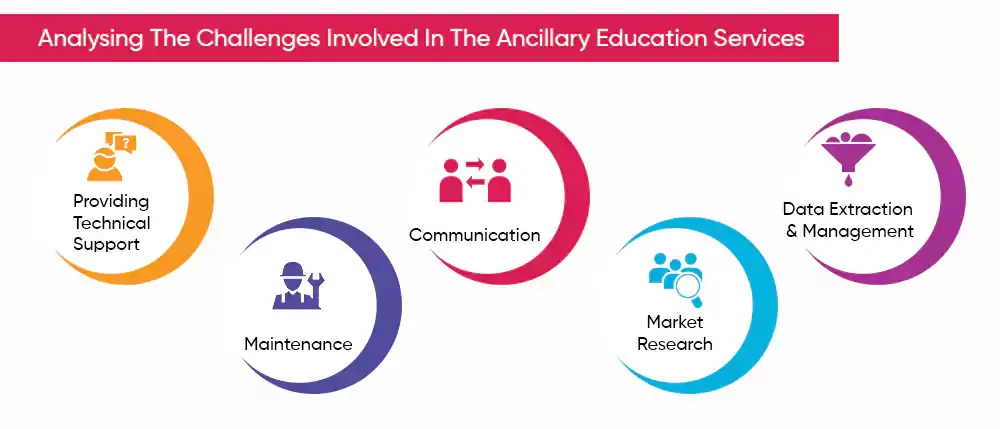
Because this sector comprises multiple inter and intra-connected aspects, tons of challenges in varying levels of intensities exist. They either create a dominos effect of consequences or stall the progress of a process completely. Let's individually explore what the challenges are.
Providing Technical Support
Experts like education consultants, policy makers, investment researchers and more are constantly required to be on standby to offer optimum assistance to stakeholders. Education is something that is not only perennial but unbound by time as well. A student could be looking at a course or a particular university at night and get in touch with the associates or support staff for assistance. If age-old mechanisms are deployed, a potential student is lost forever.
Delays in offering assistance, resolving conflicts, providing clarity and more cause unnecessary concerns for stakeholders and these could be easily avoided through appropriate tech intervention.
Maintenance
An institution is bound to have equipment and devices as part of its infrastructure. It could be a computer for administration or student purposes, lab equipment, experiment apparatuses, facilities, surveillance systems, interactive boards and more. When such devices are part of an institute's ecosystem, what becomes crucial is their maintenance, which includes their diagnosis, inspection, upgrades and preventive servicing.
To further breakdown service requests, these could be:
- updating or modifying hardware and software of devices
- adding or removing users from systems
- backup of files and repositories
- inspecting the functioning of lab equipment and apparatuses
- blocking websites and links
- upgrading surveillance systems and more
When instances of malfunction happen, an institution administrator can either get the device serviced through in-house teams or outsourced personnel. In case of the latter, it becomes difficult for institutions to track vendors, raise invoices, schedule servicing, maintain confidentiality of institutions and more. Also, when malfunctioning occurs it disrupts the regular functioning of an ecosystem.
Communication
Communication is key in the ancillary education services sector. Education consultants should communicate their research and analyses of required institutes to their clients, investment service providers should communicate their demands and expectations to their associated institutions, policy makers should communicate amendments, insights from data touchpoints, suggestions and more to their panels and stakeholders and more.
With obsolete paper-based technologies, this communication delays the progress of tasks and makes collaboration and tracking close to impossible. If each policy maker in a committee of 7 comes up with a suggestion, including them for discussion and modifying them would be a task in itself. This would give rise to cases such as lost in translation, lost in transcription and more, causing loss of crucial data or pointer. From lack of agendas to absence of digital minutes of meetings, tasks would only be haywire in any concerned process.
Market Research
Sectors like education investment, education consultants and policy specialists have to conduct tons of market research to realize their collective goals. Before an investment is channelled into an organization, market research has to be done on its reputation, pedagogy, placement assistance, excellence and academic records of students, word of mouth, recognitions and awards and more. Wrong or miscalculations could prove to be expensive to researchers and investors.
Similarly, consultants should conduct extensive research about universities before suggesting them to their clients. If a preferred university is located in a foreign country, the stakes are only higher. The lack of market research tools and techniques to generate insights and visualize them leaves stakeholders in a dark spot, often clueless and vague.
Data Extraction and Management
Usually, when we talk about data generation and processing, we tend to make it seem like it's very simple. The general visual of data analytics is feeding data into an algorithm and insights magically appearing at the other end. Well, this is a major misconception.
For those of you who didn't know, close to 80% of the data generated is unstructured. In simple words, this means that these data sets don't belong to a particular format, length or parameter. Examples of unstructured data include data in videos, documents, images, social media posts and more. In offline techniques, paper-based invoices, journal entries, physical documents, MRI scans, maps and more fall under unstructured data.
These data sets contain crucial insights about the functioning of the industry, competition, market conditions, consumer behavior and more. But these can be viewed only when processed and doing that is extremely difficult. This is because of two things – they are all over the place and compiling them without proper tools and techniques takes a lot of time. In that case, the management of such data becomes tedious as well.
With ancillary education services subjected to a range of unstructured data, it becomes extremely difficult for them to offer airtight insights and inferences.
What Are The Solutions To These Challenges?
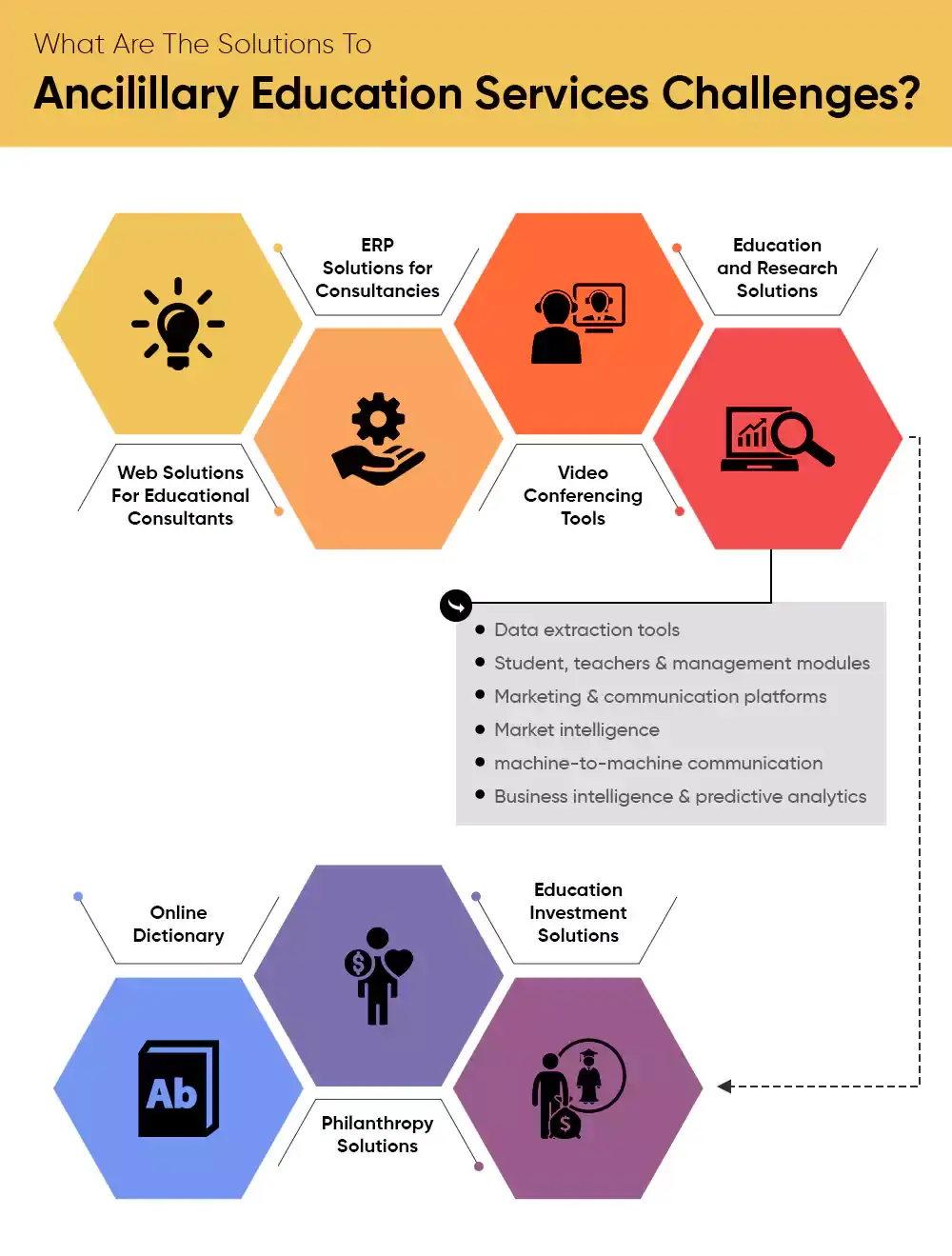
Despite the challenges looking daunting and complex, the solutions to them are rather simple. Sometimes they could be the development of an independent portal and at times it could be an application doing the required job. To give a better idea of the probable solutions at hand, we have presented a range of tech-driven fixes here.
Let's check them out.
Web Solutions For Educational Consultants
Web solutions for educational consultants are like search engines to get quick results and insights on some of their most search queries and questions. If you think, educational consultants answer a set of commonly repeated questions on a daily basis such as ideal institute recommendations, insights on placements in a given period of time, duration of the course and modules, certifications, fees structure, financing, eligibility and requirements and more.
With the development of a custom web solution, consultants can pull out all the necessary information they need to present to their clients in one click. This eliminates the need to Google search individually for multiple universities or institutions. Instead, they could retrieve multiple results at once and present them in a visualized form and even compare them for better comprehension. This also ensures work happens seamlessly even if a few associates are on leave.
ERP Solutions for Consultancies
Consultancies, on a daily basis, repeat a cycle of redundant tasks. From accounting and staffing to risk management, compliance and follow ups and scheduling, a major chunk of the consultant's time is spent on these tasks. But that doesn't have to be the case with the deployment of ERP solutions.
In simple words, ERP stands for Enterprise Resource Planning. This is nothing but a software application built considering the specific needs of the business, and the type of work involved in the organization. They bring together multiple teams, streamline processes, assist in effective communication and transfer of information, ensure data integrity and do more.
With ERP solutions, consultants can automate a lot of their tasks like sending brochures on emails, scheduling meetings, following up with prospects, helping in selection processes, forwarding SOPs and more. Statistics also reveal that close to 95% of the companies that implemented ERP solutions in their systems have experienced significant improvements in their processes.
Video Conferencing Tools
Investors, consultants, policy makers and other experts are subjected to frequent meetings. They could be heads of institutions, diplomats, prospects or any crucial stakeholder in the process. Without a video conferencing tool, associated people would have to travel in person or communicate through other mediums like calls and emails, which is not only time-consuming but isn't fool-proof as well.
With the help of video conferencing tools, virtual meetings can be held for a more elaborate conversation and get pointers, information and messages directly conveyed to respective stakeholders. Investors could virtually have a look at the infrastructure and facilities before they invest their money, consultants can run seminars or webinars on why studying in a particular country is ideal for that particular course or program and similar scenarios.
With the pandemic further nailing this requirement, now would be a good time to deploy video conferencing tools and give your facilities an upgrade.
Education and Research Solutions
Education and research are crucial aspects in the education system. If you pay close attention, there are a lot of loopholes in the current education system and teaching methodologies. Dropout ratios, unemployability statistics and more reveal harsh truths about the gap that exists between what students learn and what is expected out of them when they join an industry. There is a drastic disconnect between theoretical and practical skills. Several course modules and programs are irrelevant today but are still taught in institutes. Vocational courses also implement tools and techniques that are obsolete.
If there is one wing that could fix all these loopholes, it is the education and research solutions service providers. They can assess and evaluate the effectiveness of course and programs, improve infrastructure, optimize outcomes, make students career-ready and do more. But for that, they need to be equipped with the latest tools and technologies. Fortunately, there are several solutions available. Let's look at some of them.
- Data extraction tools for researchers, where unstructured and structured data can be extracted and processed individually for insights and even maintained and archived for the future
- Student, teachers and management modules that could bring everyone together and collectively gather insights and suggestions to discover aspects that go unnoticed because of lack of data touchpoints
- Marketing and communication platforms to automate campaigns, track campaign performances, sort and modify competitions, execute marketing specific actions such as keyword analysis, reputation management, email blasts, segmented targeting and more
- Market intelligence to compile information on market conditions such as competitions, competitor behavior and updates, consumer behaviors, trending topics or subjects, courses or programs that are in demand, their forecast for the future and more
- device-specific tech features like machine-to-machine communication for automation of redundant tasks, location-based services to offer the most precise and practical solutions to seekers and voice recognition to accommodate new trends in search and information access
- Business intelligence and predictive analytics to estimate the impact of a course or a module for an upcoming academic year, assess and forecast student performances, understand student behavior and thought processes, forecast and fight institute dropouts, optimize engagement, develop new modules for more impactful learning, reporting automation and more
Education Investment Solutions
Education investment solutions give stakeholders a better idea of where to invest or channel funding to make a meaningful impact in the lives of associated students, staff and institute reputation. Funding cannot be blindly invested into segments based on assumptions and instincts. They need to be properly studied, analysed and reported before a final decision could be taken. From building additional labs to fixing current infrastructure loopholes, priorities and SWOT analyses have to be made to ensure the investment makes changes evident.
Besides, education investment solutions also help stakeholders source funding for their investments through automated tasks and scheduling processes for meeting and pitching.
Philanthropy Solutions
These systems enable philanthropists to make generous donations for the welfare of institutions. Though it sounds simple, there are intricacies involved such as discretionary investments, advisory investments, charities to trusts, non-profit organizations, schools and universities and more. The most complicated aspect in philanthropy is that the processes in each segment differs in terms of paperwork and legalities. With philanthropy solutions, a lot of processes and prerequisites can be met and automated with simple steps and shorten the time stakeholders have to wait to receive funding.
Online Dictionary
Communication in ancillary education services is not linear. There are tons of barriers involved such as language and ethnicity. To communicate and have an inclusive conversation, it is ideal to be prepared with multilingual capabilities virtually. With online dictionaries and translation systems, this can be achieved easily, where consultants, investors, trustees and more can communicate with people from diverse ethnicities easily. When incorporated into apps, it makes the process simpler as well.
The Future of Ancillary Education Services Sector
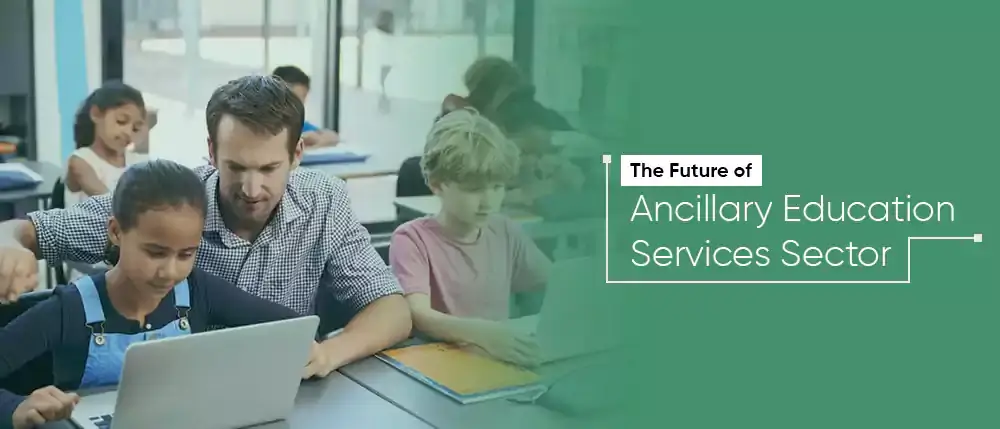
Solid tech-based revamps are inevitable. From what you read; we are sure you would agree that there needs to be changes in the way things are functioning in this sector. But the future certainly looks promising and there is ample scope for service providers to adapt and embrace futuristic technologies today to fix their loopholes and optimize their processes.
We are looking at technologies like blockchain development to deliver tamper-proof services to policy makers and investors in circulating confidential information among stakeholders. Digital contracts powered by blockchain technology could be a norm in forwarding and approving mandates.
We are also looking at market research simulators that forecast the probability of matching parameters with expectations and give airtight results on requirements. For instance, students and aspirants could provide their interests and share their results of psychometric tests and run a simulation on their preferred universities or institutes to understand where they stand when they graduate and how their future would look like. This allows them to take informed decisions based on current and past data and activities.
Apart from these, we are also looking at large scale implementation of technologies like augmented reality & virtual reality, artificial intelligence & machine learning, deep learning and more in these sectors.
Wrapping Up
The future does look exciting, right? Well, if you are an ancillary education service provider, we are sure you would have gotten clarity on a lot of aspects of running your venture. Now, all you need to do is identify the loopholes and scopes of improvement in your organization and get them resolved through custom built ERPs, Mobile applications development, or investment solutions.
Get in touch with us to discuss your project details and we will ensure you have the most realistic tool you need to propel your business forward and simultaneously make a positive impact in the lives of your stakeholders.
Call us today.